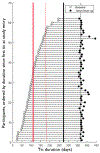The New Tics study: A Novel Approach to Pathophysiology and Cause of Tic Disorders
- PMID: 32587895
- PMCID: PMC7316401
- DOI: 10.20900/jpbs.20200012
The New Tics study: A Novel Approach to Pathophysiology and Cause of Tic Disorders
Abstract
We report on the ongoing project "The New Tics Study: A Novel Approach to Pathophysiology and Cause of Tic Disorders," describing the work completed to date, ongoing studies and long-term goals. The overall goals of this research are to study the pathophysiology of Provisional Tic Disorder, and to study tic remission (or improvement) in a prospective fashion. Preliminary data collection for the project began almost 10 years ago. The current study is nearing completion of its third year, and has already reported several novel and important results. First, surprisingly, at least 90% of children who had experienced tics for only a mean of 3 months still had tics at the 12-month anniversary of their first tic, though in some cases tics were seen only with remote video observation of the child sitting alone. Thus almost all of them now had a DSM-5 diagnosis of Tourette's Disorder or Persistent (Chronic) Tic Disorder. Baseline clinical features that predicted 12-month outcome included tic severity, subsyndromal autism spectrum symptoms, an anxiety disorder, and a history of 3 or more phonic tics. Second, we found that poorer tic suppression ability when immediately rewarded for suppression predicted greater tic severity at follow-up. Third, striatal volumes did not predict outcome as hypothesized, but a larger hippocampus at baseline predicted worse severity at follow-up. Enrollment and data collection continue, including functional connectivity MRI (fcMRI) imaging, and additional analyses are planned once the full sample is enrolled.
Keywords: MRI; Provisional Tic Disorder; Tourette syndrome; anxiety; hippocampus; inhibition (psychology); prognosis; tic disorders; tic suppression.
Figures


Similar articles
-
Hippocampal Volume in Provisional Tic Disorder Predicts Tic Severity at 12-Month Follow-up.J Clin Med. 2020 Jun 3;9(6):1715. doi: 10.3390/jcm9061715. J Clin Med. 2020. PMID: 32503289 Free PMC article.
-
Provisional Tic Disorder is not so transient.Sci Rep. 2019 Mar 8;9(1):3951. doi: 10.1038/s41598-019-40133-4. Sci Rep. 2019. PMID: 30850688 Free PMC article.
-
Tic Suppression in Children With Recent-Onset Tics Predicts 1-Year Tic Outcome.J Child Neurol. 2019 Oct;34(12):757-764. doi: 10.1177/0883073819855531. Epub 2019 Jun 26. J Child Neurol. 2019. PMID: 31241402 Free PMC article.
-
Tic disorders and Tourette's syndrome.Eur Child Adolesc Psychiatry. 2013 Feb;22 Suppl 1:S55-60. doi: 10.1007/s00787-012-0362-x. Eur Child Adolesc Psychiatry. 2013. PMID: 23224240 Review.
-
Provisional Tic Disorder: What to tell parents when their child first starts ticcing.F1000Res. 2016 Apr 18;5:696. doi: 10.12688/f1000research.8428.1. eCollection 2016. F1000Res. 2016. PMID: 27158458 Free PMC article. Review.
Cited by
-
Case Report: DSM-5 misses an edge case in tic disorders nosology.F1000Res. 2020 Jun 3;9:505. doi: 10.12688/f1000research.23991.1. eCollection 2020. F1000Res. 2020. PMID: 32595960 Free PMC article.
-
Course of tic disorders over the lifespan.Curr Dev Disord Rep. 2021 Jun;8(2):121-132. doi: 10.1007/s40474-021-00231-3. Epub 2021 Apr 10. Curr Dev Disord Rep. 2021. PMID: 34178575 Free PMC article.
-
Functional tic-like presentations differ strikingly from Provisional Tic Disorder.F1000Res. 2023 Apr 17;11:1566. doi: 10.12688/f1000research.129252.2. eCollection 2022. F1000Res. 2023. PMID: 37224324 Free PMC article.
-
Correlating clinical course with baseline subcortical shape in provisional tic disorder.CNS Spectr. 2024 Dec;29(6):652-664. doi: 10.1017/S1092852924002190. Epub 2024 Nov 28. CNS Spectr. 2024. PMID: 39604269 Free PMC article.
-
Hippocampal Volume in Provisional Tic Disorder Predicts Tic Severity at 12-Month Follow-up.J Clin Med. 2020 Jun 3;9(6):1715. doi: 10.3390/jcm9061715. J Clin Med. 2020. PMID: 32503289 Free PMC article.
References
-
- Black KJ. Tics In: Kompoliti K, Verhagen Metman L, Cornelia C, Goetz C, Goldman J, Kordower J, et al., editors. Encyclopedia of Movement Disorders. Oxford (UK): Elsevier (Academic Press); 2010. p. 231–6.
-
- Schlaggar BL, Mink JW. Movement disorders in children. Pediatr Rev. 2003;24(2):39–51. - PubMed
-
- Leckman JF, Zhang H, Vitale A, Lahnin F, Lynch K, Bondi C, et al. Course of tic severity in Tourette syndrome: the first two decades. Pediatrics. 1998;102(1 Pt 1):14–9. - PubMed
-
- The Tourette Syndrome Classification Study Group. Definitions and classification of tic disorders. Arch Neurol. 1993;50(10):1013–6. - PubMed
-
- American Psychiatric Association. Diagnostic and Statistical Manual of Mental Disorders, Fifth Edition Arlington (VA, USA): American Psychiatric Association; 2013.
